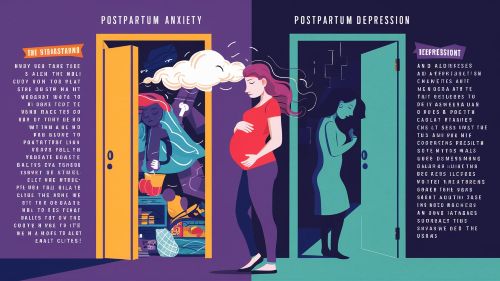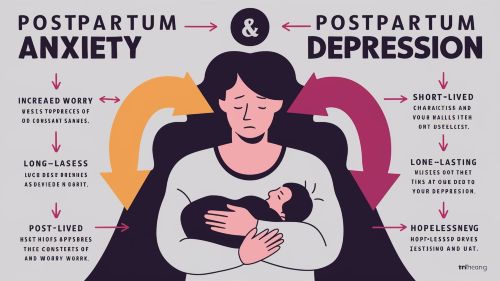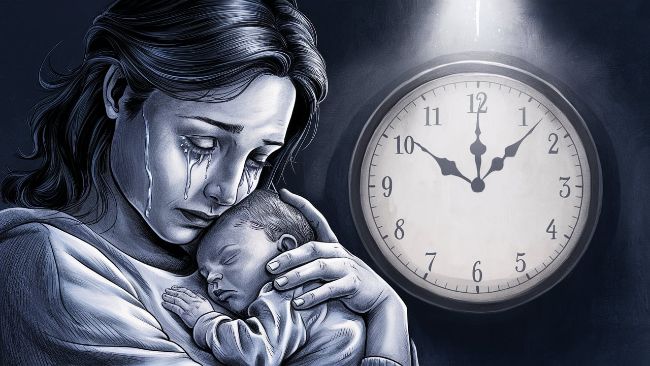If you’re reading this, chances are you’re in the thick of it. The joy you expected to feel after childbirth is clouded by a persistent fog of sadness, anxiety, or numbness. In the quiet moments, when the baby is finally asleep, you find yourself staring at the ceiling, asking a question that feels both desperate and vital: How long does postnatal depression usually last?
You are not alone in asking this. It’s a question born from a deep need for a finish line, a glimmer of light at the end of a very dark tunnel. You want to know when you will feel like “you” again.
The short, clinical answer is that the duration of Postnatal Depression (PPD), also known as Perinatal Depression, varies significantly from person to person. But that answer isn’t enough.
In this comprehensive guide, we will walk you through the real, nuanced answer. We’ll explore the timelines, the factors that influence recovery, the critical role of treatment, and most importantly, we will reaffirm the one truth you need to hold onto: PPD is temporary, and you will get better.
[Insert a compelling, hopeful image here of a mother looking contemplatively out a window, or a supportive hand on a shoulder.]
First, Let’s Distinguish: Baby Blues vs. Postnatal Depression
One of the first steps in understanding the timeline is correctly identifying what you’re experiencing. Many new mothers experience the “baby blues,” but PPD is a more severe and persistent condition. Confusing the two can delay getting the right help.
The baby blues are extremely common, affecting up to 80% of new mothers. They are caused by the dramatic hormonal shifts after childbirth, combined with sleep deprivation and the stress of a new baby.
Postnatal Depression is a clinical mood disorder that requires intervention.
Here’s a quick comparison to help you tell the difference:
| Feature | The “Baby Blues” | Postnatal Depression (PPD) |
|---|---|---|
| Timing | Starts 2-3 days after delivery. | Can start anytime in the first year, often within 1-3 months. |
| Duration | Lasts for a few days up to two weeks and resolves on its own. | Lasts for more than two weeks and often worsens without treatment. |
| Symptoms | Mood swings, weepiness, anxiety, feeling overwhelmed, trouble sleeping. | Intense sadness, severe mood swings, loss of pleasure (anhedonia), feelings of worthlessness or guilt, difficulty bonding with the baby, thoughts of harming self or baby. |
| Severity | Symptoms are generally mild and come and go. You still have moments of happiness. | Symptoms are persistent and severe enough to interfere with your ability to care for yourself or your baby. |
| Resolution | Goes away on its own without medical treatment. | Requires professional help (therapy, medication, support groups) to resolve. |
Key Takeaway: If your symptoms have lasted for more than two weeks and are impacting your daily life, it is crucial to move past the “baby blues” label and consider the possibility of PPD. Speaking with a healthcare provider is the essential next step. [Link to your article on PPD symptoms]
The Typical Timeline of Postnatal Depression
So, if it’s more than the baby blues, what does the PPD recovery timeline look like? While there is no universal calendar, we can look at common patterns and phases of recovery.
The Onset and Peak (First 1-3 Months)
For many women, PPD symptoms begin to emerge within the first few weeks to three months postpartum. This period can be the most intense and confusing. The hormonal rollercoaster is still in full swing, sleep deprivation is at its peak, and the reality of 24/7 infant care is setting in.
During this phase, symptoms like constant crying, overwhelming anxiety, and a feeling of being completely disconnected from the baby can be at their strongest. This is often when a diagnosis is made, assuming the mother or a loved one recognizes the signs and seeks help.
The Turning Point (3-6 Months)
With proper treatment, the period between three and six months postpartum is often a turning point. This is not a sudden, magical recovery. It’s a slow, often two-steps-forward-one-step-back process.
- If on Medication (SSRIs): Antidepressants typically take 4-8 weeks to become fully effective. By the 3-month mark, many women begin to feel the “fog” lifting. The intense lows become less frequent, and they may experience more “okay” days.
- If in Therapy: Consistent therapy sessions (like Cognitive Behavioral Therapy or Interpersonal Therapy) start providing coping mechanisms. You begin to challenge the negative thought patterns and develop strategies for managing anxiety.
- Improved Sleep: By this stage, some babies may be settling into more predictable sleep patterns (though not all!), which can have a monumental impact on a mother’s mental health.
Recovery is not linear. You might have a good week followed by a few bad days. This is normal. The key is that the overall trajectory is moving upwards.
Finding a New Normal (6-12 Months)
For many individuals who receive timely and effective treatment, a significant reduction in PPD symptoms is seen by the time the baby is six to twelve months old. By this point, “recovery” doesn’t mean you never have a bad day; it means you have the tools to manage it.

You may feel more like yourself, find joy in activities again, and feel a strong, secure bond with your child. Treatment may continue during this period, often with a focus on maintaining stability and preventing relapse.
A Note on Weaning from Medication: If you are on medication, your doctor will likely recommend you stay on it for at least 6-12 months after you start feeling well to reduce the risk of relapse. Never stop taking medication without consulting your doctor.
[Insert a simple infographic or a graphic with a quote: “Recovery is not a straight line. It’s a journey of healing, one day at a time.”]
Critical Factors That Influence How Long PPD Lasts
The “3 to 12 months” timeline is a general guideline. Your personal journey will be shaped by a unique combination of factors. Understanding these can empower you to take control of what you can and have patience with what you can’t.
1. Timing of Diagnosis and Treatment
This is arguably the single most important factor. The longer PPD goes untreated, the more entrenched the thought patterns and behaviors can become, and the longer recovery may take.
- Early Intervention: Seeking help at the first signs (after the 2-week baby blues window) can significantly shorten the duration and severity of the illness.
- Delayed Treatment: Unfortunately, due to stigma, lack of awareness, or difficulty accessing care, many suffer in silence for months. This can prolong the recovery process.
2. The Severity of Symptoms
PPD exists on a spectrum. Mild PPD, where a mother is still functional but struggling internally, may resolve more quickly with therapy and support. Severe PPD, which can include debilitating depression, panic attacks, or intrusive thoughts, often requires a more intensive treatment plan, including medication, and may have a longer recovery timeline.
3. The Quality and Consistency of Treatment
Simply getting a diagnosis isn’t enough. The type and quality of your treatment matter immensely.
- The Right Therapy: Finding a therapist who specializes in perinatal mental health can make a world of difference.
- The Right Medication: It can sometimes take trial and error to find the antidepressant that works best for you with the fewest side effects.
- Consistency: Attending therapy sessions regularly and taking medication as prescribed is non-negotiable for a steady recovery.
4. Your Support System
A strong support system is like a scaffold during recovery.
- A Supportive Partner: A partner who is educated about PPD, emotionally supportive, and willing to take on a larger share of household and baby duties is invaluable.
- Friends and Family: Non-judgmental help—whether it’s bringing a meal, watching the baby so you can nap, or just listening—reduces the immense pressure that can worsen PPD.
- Lack of Support: Isolation and feeling like you have to do it all alone is a significant risk factor for prolonged PPD.
5. Personal and Genetic History
Your own history plays a role. If you have a history of depression or anxiety, or a family history of mood disorders, you may be more susceptible to a more severe or longer-lasting episode of PPD. This doesn’t mean your fate is sealed, but it does underscore the importance of proactive and robust treatment.
6. Lifestyle and Self-Care
While self-care cannot “cure” clinical depression, it is a vital component of recovery that can influence its duration.
- Sleep: Prioritizing sleep is the most powerful form of self-care for a new mother. This is where your support system comes in.
- Nutrition: A balanced diet can help stabilize mood and energy levels.
- Movement: Gentle exercise, like a daily walk, releases endorphins and can be a powerful antidepressant.
- Stress: High levels of external stress (financial worries, relationship conflict, a difficult baby) can impede recovery.
But Can Postnatal Depression Last for Years?
This is a deep-seated fear for many. You worry: “What if this is my new reality?”
The honest answer is that for a small percentage of individuals, yes, PPD can become a chronic or persistent depressive disorder if left untreated or inadequately treated.
One landmark study published in the Harvard Review of Psychiatry found that up to 50% of women with PPD who went untreated still had symptoms a year later, and a significant number were still depressed three years postpartum.
This statistic is not meant to scare you. It is meant to motivate you.
It highlights that PPD is not something that reliably “goes away on its own.” Hope does not come from waiting; it comes from acting. If you are a year or more postpartum and still struggling with depressive symptoms, it is not too late. You may be dealing with persistent PPD, and there is still effective treatment available.
A Message of Hope:
“I was diagnosed with PPD when my son was four months old. It took another six months of therapy and medication to feel the sun again. But the real healing happened in the second year. By his second birthday, I felt stronger and more resilient than I had before he was born. It was a long road, but it had an end. Please, don’t give up five minutes before the miracle.”
— Sarah, a mom of one
The Role of Treatment in Shortening PPD’s Grip
Treatment is the single most effective way to shorten the duration of postnatal depression. It’s not a sign of weakness; it’s the path to getting well. Let’s break down the core components.
Therapy (Psychotherapy)
- Cognitive-Behavioral Therapy (CBT): Helps you identify, challenge, and change negative thought patterns and behaviors.
- Interpersonal Therapy (IPT): Focuses on your relationships and how they impact your mood, helping you resolve conflicts or adapt to new roles.
- Finding a Therapist: Look for a professional who specializes in perinatal mental health. Resources like Postpartum Support International (PSI) can help you find one.
Medication
For moderate to severe PPD, medication is often a crucial part of the treatment plan. Selective Serotonin Reuptake Inhibitors (SSRIs) are the most commonly prescribed antidepressants.
- Are they safe for breastfeeding? Many SSRIs are considered safe for use while breastfeeding. Your doctor will discuss the risks and benefits with you to choose the best option.
- How long do they take? It can take 4-8 weeks to feel the full effects. Be patient and stay in close contact with your doctor.
Support Groups
Connecting with other mothers who get it is incredibly validating and powerful. It shatters the isolation that PPD thrives on. You learn from others’ experiences, share your struggles without judgment, and are reminded that recovery is possible.
- Check with local hospitals, community centers, or PSI for virtual and in-person support groups.
Holistic and Self-Care Strategies

These are not replacements for professional treatment, but they are essential complements that support and can speed up your recovery.
- Prioritize Sleep: This is non-negotiable. Arrange “sleep shifts” with your partner. Accept offers from family to watch the baby so you can nap. Sleep is medicine.
- Move Your Body: Even a 15-minute walk outside can improve your mood.
- Nourish Yourself: Try to eat regular, balanced meals. Low blood sugar can mimic and worsen anxiety.
- Lower Your Expectations: You do not need a perfect house or a gourmet dinner. Your only job right now is to care for your baby and yourself. Let everything else go.
- Connect: Force yourself, even when you don’t want to, to talk to a friend or your partner. Voice the scary thoughts. Connection is the antidote to shame.
[Insert an image here of two mothers talking over coffee, or a woman practicing yoga at home.]
A Word for Partners and Loved Ones
If you are supporting someone with PPD, you may also be wondering how long it will last. You feel helpless and miss the person you know and love. Your role is critical.
- Educate Yourself: Read about PPD. Understand that she is not choosing to be this way.
- Listen Without Judgment: Don’t try to “fix” it. Just listen and validate her feelings. Say, “That sounds incredibly hard. I’m here with you.”
- Take Action: Don’t ask, “What can I do?” Instead, say, “I am going to take the baby for two hours so you can sleep/shower/go for a walk.” Proactive help is the most effective.
- Encourage Professional Help: Gently and persistently encourage her to speak with a doctor or therapist. Help her make the appointment if needed.
- Take Care of Yourself: You cannot pour from an empty cup. This is stressful for you, too. Ensure you have your own support.
Frequently Asked Questions (FAQ)
Q1: When does postnatal depression usually peak?
While it varies, many experts find that PPD symptoms often peak around 3-4 months postpartum, especially if left untreated. This is often a point of crisis where individuals are most likely to seek help.
Q2: Can postnatal depression go away on its own?
Unlike the baby blues, PPD rarely resolves on its own. Attempting to “wait it out” or “push through it” often leads to a longer and more severe depressive episode. Professional intervention is the most reliable path to recovery.
Q3: Can I get PPD a year after giving birth?
Yes. PPD is defined as depression that occurs anytime within the first 12 months after childbirth. It is less common for it to start that late, but it is absolutely possible, especially around major transitions like returning to work or weaning.
Q4: If I had PPD with my first baby, will I get it again?
Having PPD once is a significant risk factor for having it again in subsequent pregnancies. The risk can be as high as 50%. However, this also means you are prepared. You can create a proactive mental health plan with your doctor and support system to mitigate the risk and ensure early intervention if symptoms do appear.
The Final Takeaway: There is a Light Ahead
So, how long does postnatal depression usually last?
With prompt and consistent treatment, most people see significant improvement within 6-12 months. Without treatment, it can last for years.
But the duration is not a passive waiting game. It is an active process of seeking help, building a support system, being patient with yourself, and taking one small step at a time.
Recovery isn’t a switch that flips. It’s a sunrise. At first, it’s just a faint glow on the horizon, barely perceptible. But slowly, gradually, the light begins to spread, chasing the shadows away until you find yourself standing in the warmth of a new day, holding your child, and feeling like yourself again.
That day will come. Hold on.
Disclaimer: This article is for informational purposes only and does not constitute medical advice. If you are struggling with symptoms of postnatal depression, please contact a healthcare provider, a mental health professional, or a crisis hotline immediately. You can reach the Postpartum Support International helpline at 1-800-944-4773.
